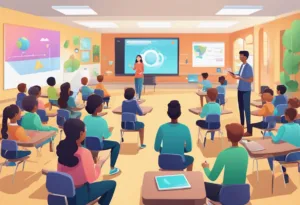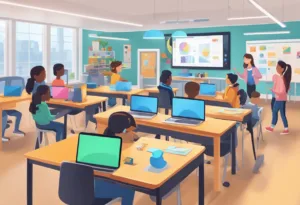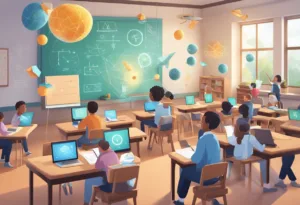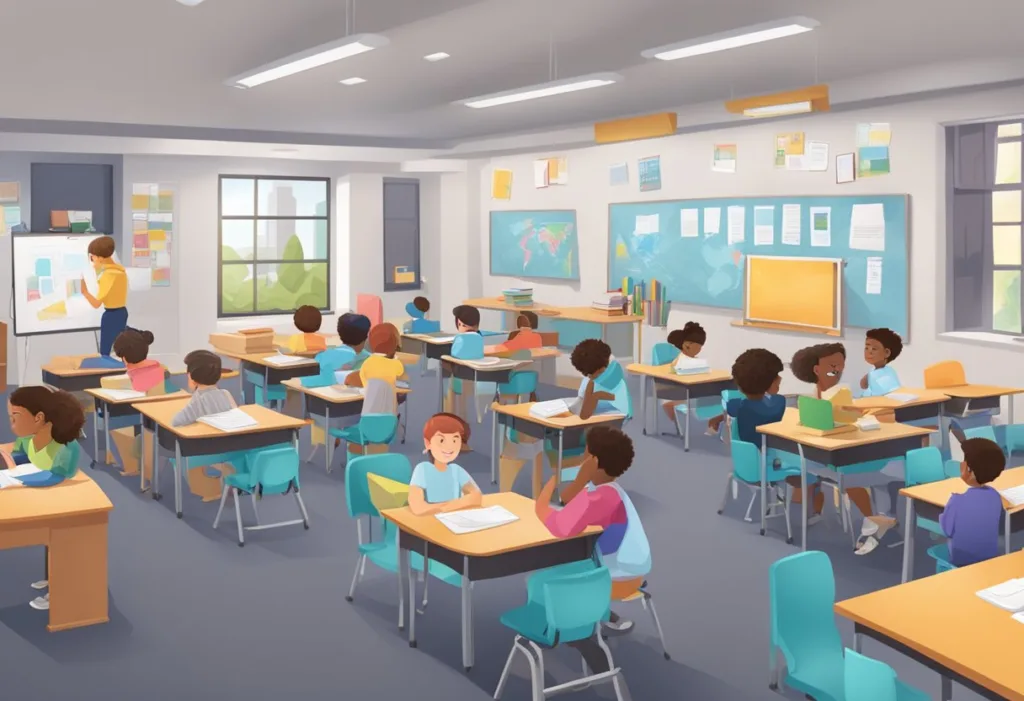AR technology is revolutionizing the way we learn, making education more engaging, interactive, and accessible. By overlaying digital information on the real world, AR enhances learning by providing students with a more immersive and interactive experience that caters to different learning styles. From science to art, AR has the potential to transform the way we teach and learn. In this blog post, I will discuss AR and education and share with you the various ways you can integrate AR and education
The role of AR in modern education is expanding rapidly, with applications across disciplines such as engineering, medicine, and architecture. AR technology is being used to create simulations, visualizations, and interactive content that helps students grasp complex concepts and theories. By providing a more interactive and engaging learning experience, AR technology can help students retain information better and improve their overall academic performance.
Integrating AR in educational institutions can be a game-changer for education, making learning more accessible and inclusive for all students. AR technology can help bridge the gap between different learning styles and cater to students with disabilities. By providing a more engaging and interactive learning experience, AR technology can help students develop critical thinking, problem-solving, and collaboration skills that are essential for success in the modern world.
The Role of AR in Modern Education
As technology continues to advance, educators are constantly searching for ways to enhance the learning experience and improve student engagement. One technology that has shown promise in achieving these goals is augmented reality (AR). AR is a technology that overlays digital information, such as sounds, videos, and graphics, on top of the real-world environment. In modern education, AR is being used to create interactive classrooms that engage students in a more immersive and interactive way.
Evolution of Educational Technology
The use of technology in education has come a long way since the days of chalkboards and overhead projectors. Today, technology has become an integral part of the modern classroom, with educators using a variety of tools, such as laptops, tablets, and interactive whiteboards, to enhance the learning experience. AR is the latest addition to this list of educational technologies, and it has the potential to revolutionize the way students learn.
AR Versus VR in the Classroom
While both augmented reality (AR) and virtual reality (VR) are immersive technologies that can enhance the learning experience, there are some key differences between the two. VR creates a completely artificial environment, while AR overlays digital information on top of the real-world environment. In the classroom, AR is often preferred over VR because it allows students to remain connected to the real world while still providing an immersive and interactive learning experience.
AR has the potential to transform the way students learn by making the learning experience more engaging and interactive. With the use of AR, educators can create interactive classrooms that allow students to explore and learn in a more immersive way. As technology continues to advance, it is likely that AR will become an even more important tool in the modern classroom.
How To Integrate AR and Education

- Interactive Textbooks
- Enhanced Field Trips
- Practical Skill Development
- Gamified Learning
- Collaborative Learning
- Visualization of Abstract Concepts
- Language Learning Enhancement
- Historical Reconstruction
- Accessibility for Special Needs
- Remote Learning Enhancement
Interactive Textbooks
Interactive textbooks that leverage augmented reality (AR) technology can transform the learning experience by making the content more engaging and interactive. These textbooks allow students to visualize complex diagrams and 3D models by simply scanning images or pages with their devices.
This not only helps in retaining information better but also makes learning more enjoyable. For instance, a biology textbook could bring to life the human anatomy, allowing students to explore the body’s systems in a more immersive way. This technology can also provide instant access to additional resources such as videos and interactive quizzes, further enriching the educational material.
Enhanced Field Trips
AR can take students on virtual field trips to places that are otherwise inaccessible due to geographical or financial constraints. By using AR applications, teachers can guide students through historical sites, distant planets, or even microscopic worlds, providing a rich contextual learning experience without leaving the classroom. This not only saves time and resources but also ensures that all students have the opportunity to explore and learn from environments that would be out of reach.
Practical Skill Development
In technical and vocational education, AR can be used to teach practical skills in a safe and controlled environment. For example, medical students can practice surgeries, or automotive students can learn about engine mechanics without the risk associated with real-life practice. AR provides a platform for students to learn through trial and error, gaining confidence in their abilities before applying them in real-world scenarios.
Gamified Learning
Gamifying the learning process with AR can make education more engaging and fun. By incorporating game elements such as points, levels, and challenges into educational content, students can be motivated to learn and achieve their goals. AR games can be particularly effective in encouraging students to solve problems, complete tasks, and understand complex concepts while enjoying the learning process.
Collaborative Learning
AR can facilitate collaborative learning by connecting students in the same classroom or from different parts of the world. Through AR, group projects can become more interactive, as students can manipulate and interact with shared virtual objects in real-time. This fosters teamwork and communication skills, as students must work together to solve problems or create projects in an AR environment.
Visualization of Abstract Concepts
AR can help in visualizing abstract concepts that are difficult to grasp through traditional teaching methods. By bringing these concepts to life, students can better understand and relate to the material. For example, visualizing mathematical equations or scientific theories in three dimensions can provide a more concrete understanding of otherwise intangible ideas.
Language Learning Enhancement
Language learning can be greatly enhanced by AR, as it can simulate immersive environments where learners can practice new vocabulary and grammar in context. For instance, students can be transported to a virtual marketplace where they must communicate in the target language to complete transactions, thereby improving their language skills in a realistic setting.
Historical Reconstruction
AR can be used to recreate historical events or bring extinct species back to life, providing students with a vivid understanding of history and science. By visualizing these reconstructions, students can develop a deeper connection with the past, leading to a more profound appreciation of historical events and their impact on the present.
Accessibility for Special Needs
AR technology can offer customized learning experiences for students with special needs. By tailoring the content to suit individual learning styles and abilities, AR can help overcome learning barriers. For example, students with visual impairments can use AR to interact with content through auditory or tactile means, enhancing their educational experience.
Remote Learning Enhancement
With the rise of remote learning, AR can bridge the gap between physical and virtual classrooms. By integrating AR into remote learning platforms, students can engage with materials as if they were in a traditional classroom setting. This can include virtual labs, 3D models, and interactive simulations that provide a hands-on learning experience from any location.
Enhancing Learning Through AR

Augmented reality (AR) technology has the potential to revolutionize education by engaging students and enhancing their learning outcomes. AR creates interactive learning environments that allow students to explore abstract concepts in a relevant and engaging way. By using AR, educators can create educational content that is more meaningful and interactive, which can engage students and lead to effective learning.
Interactive Learning Environments
AR technology provides students with interactive learning environments that engage them in the learning process. AR can be used to create immersive learning experiences that allow students to visualize complex concepts and engage with educational content in a more meaningful way. By using AR, educators can create interactive learning environments that engage students and enhance their learning outcomes.
Visualization of Complex Concepts
AR can be used to visualize complex concepts in science and other subjects. By using AR, students can explore abstract concepts in a relevant and engaging way. AR can help students to visualize complex concepts, which can lead to a deeper understanding of the subject matter. AR can be used to create visualizations of science concepts, which can help students to understand abstract concepts in a more meaningful way.
AR has many benefits in education, including enhancing student engagement, creating interactive learning environments, and visualizing complex concepts. By using AR, educators can engage students and enhance their learning outcomes. AR can be used to create educational content that is more meaningful and interactive, which can engage students and lead to effective learning.
AR Applications Across Disciplines

AR technology is revolutionizing the way students learn across various disciplines. Here are some examples of how AR is being used in different fields of study:
Medical and Engineering Education
AR is being used to provide medical and engineering students with a better understanding of the human body and complex engineering concepts. AR applications can provide 3D models of the human body that allow students to explore and interact with different organs and systems. This technology is also being used in engineering education to provide students with interactive simulations of complex systems, such as engines and machines.
History and Space Exploration Learning
AR is being used to provide students with a more immersive learning experience in history and space exploration. AR tours of historical events and landmarks can provide students with a more engaging and interactive way to learn about the past. AR can be used to create virtual tours of space exploration sites, such as the moon and Mars, providing students with a more realistic and interactive experience.
AR technology is providing students with a more engaging and interactive way to learn across various disciplines. AR applications are being developed by researchers and educators to enhance the learning experience and provide students with a deeper understanding of complex concepts. As AR technology continues to evolve, new and innovative ways to use this technology in education will continue to emerge.
AR Accessibility and Inclusivity in Education

In recent years, the use of Augmented Reality (AR) in education has gained increasing attention due to its potential to improve accessibility and inclusivity in learning. AR technology can provide a more engaging and interactive learning experience, making it easier for students to understand complex concepts. This section will explore the role of AR in promoting accessibility and inclusivity in education.
Special Education and AR
AR technology has the potential to revolutionize special education by providing new opportunities for students with learning disabilities or attention deficit hyperactivity disorder (ADHD) to learn in a more engaging and interactive way. AR can help students visualize abstract concepts and engage with digital information in a way that is more accessible and meaningful.
For example, AR can be used to create interactive simulations that allow students to explore complex concepts in science or math. Students with learning disabilities can benefit from these simulations because they can interact with the content in a way that is more engaging and easier to understand.
Global Access to Educational Resources
AR technology can also help promote global access to educational resources by providing a more accessible and inclusive learning experience. AR can be used to create virtual classrooms that allow students from different parts of the world to learn together in a more engaging and interactive way.
AR can also be used to create interactive textbooks that allow students to engage with digital information in a more meaningful way. For example, AR can be used to create interactive diagrams that allow students to explore complex concepts in science or math.
AR technology has the potential to promote accessibility and inclusivity in education by providing a more engaging and interactive learning experience. AR can help students with learning disabilities or ADHD to learn in a more accessible way, and it can also promote global access to educational resources.
Integrating AR in Educational Institutions
Augmented Reality (AR) has the potential to transform the way education is delivered and experienced. By integrating AR technology in educational institutions, students can have a more immersive and engaging learning experience. In this section, we will discuss the different ways educational institutions can integrate AR technology.
Curriculum Development and Teacher Training
To successfully integrate AR technology in the classroom, educational institutions need to develop a curriculum that incorporates AR technology. Teachers need to be trained on how to use AR technology effectively in the classroom. The focus should be on how to use AR technology to enhance the learning experience of students.
AR technology can be used to create interactive and engaging learning experiences. For example, using AR technology, students can explore historical sites and artifacts, view 3D models of complex scientific concepts, and interact with virtual objects. Teachers should be trained on how to create AR content and how to use AR technology in the classroom.
Institutional Support and Program Implementation
To successfully implement AR technology in educational institutions, there needs to be institutional support. The Department of Education and policymakers should provide funding and support for AR technology in education. Congress should pass legislation to support the integration of AR technology in education.
Educational institutions should also provide support for the implementation of AR technology. This includes providing the necessary hardware and software, such as smartphones and graphics cards, and ensuring that the network infrastructure can support AR technology. Institutions should also provide training and support for teachers to ensure that they can effectively use AR technology in the classroom.
Integrating AR technology in educational institutions can transform the way education is delivered and experienced. By developing a curriculum that incorporates AR technology and providing training and support for teachers, educational institutions can provide students with an immersive and engaging learning experience. With the right institutional support and program implementation, AR technology can become an integral part of the education system.
Frequently Asked Questions
What are the benefits of using augmented reality in educational settings?
Augmented reality (AR) technology has the potential to enhance the learning experience by providing students with a more interactive and immersive way to engage with educational content. AR can help students visualize complex concepts, explore virtual environments, and interact with digital objects in a more meaningful way. Studies have shown that AR can improve student engagement, motivation, and knowledge retention, making it a valuable tool for educators.
How is augmented reality integrated into classroom learning experiences?
AR can be integrated into classroom learning experiences in a variety of ways. For example, teachers can use AR to create interactive presentations, simulations, and games that help students understand complex concepts. AR can also be used to create virtual field trips, allowing students to explore historical sites, museums, and other locations without leaving the classroom. AR can be used to create personalized learning experiences, allowing students to learn at their own pace and in their own way.
What are the potential drawbacks or challenges of implementing AR in education?
One potential challenge of implementing AR in education is the cost of the technology. AR devices can be expensive, and not all schools may have the budget to invest in them. Some educators may not have the technical skills or knowledge needed to effectively integrate AR into their teaching practices. Finally, there may be concerns about the potential distractions that AR technology could create in the classroom.
In what ways has augmented reality been shown to affect higher education outcomes?
Studies have shown that AR can improve higher education outcomes by increasing student engagement, motivation, and knowledge retention. AR can help students visualize complex concepts, explore virtual environments, and interact with digital objects in a more meaningful way. AR can be used to create personalized learning experiences, allowing students to learn at their own pace and in their own way.
What are some examples of free augmented reality applications suitable for educational purposes?
There are several free AR applications that are suitable for educational purposes. For example, the app “Anatomy 4D” allows students to explore the human body in 3D, while the app “Elements 4D” allows students to explore the periodic table in 3D. Other free AR apps include “Star Chart” for astronomy, “GeoGebra AR” for math, and “WWF Free Rivers” for environmental science.
How is the growth of augmented reality in the educational sector projected over the coming years?
The global market for AR in education and training is projected to grow from 10.37 billion USD in 2022 to 68.71 billion USD in 2026 at a compound annual growth rate (CAGR) of 60.4%. This growth is driven by the increasing adoption of AR technology in classrooms and schools around the world. As AR technology becomes more affordable and accessible, it is expected to become an increasingly important tool for educators.














